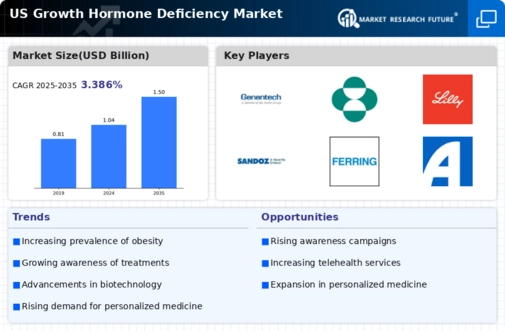The US Growth Hormone Deficiency Market is characterized by a dynamic competitive landscape driven by advancements in biotechnology and an increased understanding of growth hormone therapies. Companies within this sector focus on the development and commercialization of effective treatments aimed at addressing growth hormone deficiencies in both pediatric and adult populations. The competitive insights reveal a landscape where firms are not only engaged in research and development efforts but also actively pursue strategic collaborations, partnerships, and acquisitions to enhance their market presence.
Additionally, regulatory approvals for innovative therapies play a vital role in determining market competitiveness as firms strive to bring forth new treatments that meet the evolving needs of patients while adhering to stringent safety and efficacy standards. Genentech has established itself as a formidable player in the US Growth Hormone Deficiency Market through its robust portfolio of treatment options tailored for patients suffering from this condition. The company’s commitment to research and development has enabled it to maintain a competitive edge by innovating therapies that are both effective and well-tolerated by patients.
Genentech's strengths lie in its strong brand reputation, well-established distribution channels, and the ability to rapidly adapt to changes in market demand. Moreover, the company's focus on patient education and support programs provides added value, empowering patients and healthcare providers to make informed decisions regarding growth hormone therapies. This comprehensive approach not only bolsters Genentech's market presence but also fosters long-term loyalty among healthcare professionals and patients alike. Merck stands out in the US Growth Hormone Deficiency Market with its diverse range of products and services specifically designed to address the needs of this patient population.
The company's key offerings often include growth hormone analogs that have been shown to improve growth outcomes effectively. Merck's presence in this market is reinforced by its dedication to research, which has led to the development of innovative therapies that focus on enhancing the quality of life for individuals with growth hormone deficiencies. Strategic mergers and acquisitions have further augmented Merck's capabilities, allowing for a synergistic approach to product development and distribution. The company capitalizes on its extensive expertise in biopharmaceuticals, ensuring that it remains a key contender in the marketplace.
Additionally, Merck’s strong emphasis on clinical research and education underscores its ability to build a solid reputation among healthcare providers, thereby enhancing its competitive positioning within the US growth hormone deficiency landscape.






















